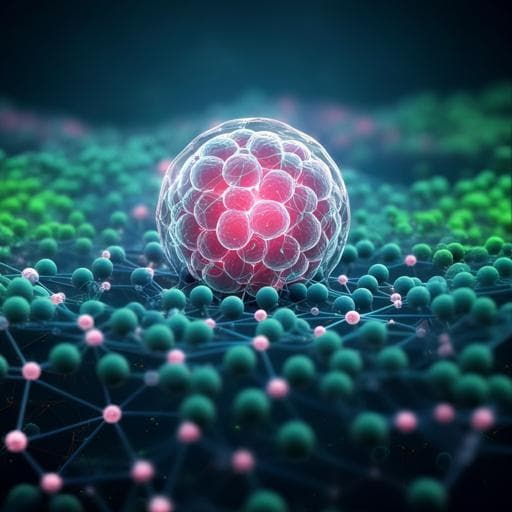
Medicine and Health
A predictive computational platform for optimizing the design of bioartificial pancreas devices
A. U. Ernst, L. Wang, et al.
Discover SHARP, a pioneering computational platform that enhances the efficacy of bioartificial pancreas devices for treating type 1 diabetes. Developed by a team including Alexander U. Ernst and Scott C. Worland from Cornell University, SHARP addresses critical oxygen transport challenges and optimizes islet structures for improved insulin secretion.
~3 min • Beginner • English
Introduction
The study addresses the challenge that bioartificial pancreas (BAP) devices, which encapsulate pancreatic islets or stem cell-derived β cell clusters (SC-βs) to avoid immunosuppression in type 1 diabetes, suffer from mass transport limitations—particularly oxygen diffusion—leading to hypoxia, impaired insulin secretion, and cell death. β-cells have high oxygen demand and in encapsulation receive oxygen only by passive diffusion from relatively low-tension host environments through low-permeability hydrogels and tissue, making device performance highly sensitive to oxygen availability. Existing device-scale models often assume uniform islet sizes, uniform distributions, or composite domains, neglecting real-world stochastic features such as broad islet size distributions and random spatial localization. The purpose is to develop a quantitative model that captures stochastic variability in islet size and seeding to predict oxygen transport, cell survival, and insulin secretion in BAPs, guide device design, and optimize curative dosing. The authors introduce SHARP (Simulated Heterogeneity and Randomness Program), a stochastic finite element platform incorporating empirical islet/SC-β size distributions and random seeding, to perform Monte Carlo simulations for user-defined geometries and conditions, and to examine how islet size distribution variance, device structure, and loading affect therapeutic potential.
Literature Review
Prior work has established islet-scale mass transport models and highlighted oxygen as a primary limiting factor for islet survival and function in encapsulation. Device-scale models frequently simplify by assuming uniform islet sizes and distributions, which can bias predictions. Clinical and preclinical studies suggest smaller islets, or reaggregated smaller clusters, perform better due to reduced diffusion distances, and clinical outcomes correlate with size metrics such as islet size index (ISI). There is recognition that oxygen-generating or transport-enhancing strategies can bolster encapsulated islet performance. However, a comprehensive device-scale framework that incorporates stochastic islet size distributions and random spatial localization has been lacking, motivating the present stochastic modeling approach.
Methodology
The authors developed SHARP, a stochastic finite element platform, to evaluate BAP devices under probabilistic assumptions for islet/SC-β diameters and random spatial localization. Key steps: (1) Empirical characterization and fitting of effective diameter distributions for islets (mouse, rat, juvenile porcine, human) and SC-βs (two sources), using lognormal or Weibull distributions on number and volume bases. (2) Device generation: For a given cell source, volumetric cell density, and geometry (planar slab, cylinder, hollow cylinder), SHARP samples islet diameters from fitted distributions and seeds spheres randomly in the hydrogel, allowing high packing densities (>40% v/v). (3) Physics implementation: Oxygen transport modeled at steady state via diffusion in hydrogel and diffusion-consumption in islets. Boundary pO2 fixed at 40 mmHg at device-host interfaces. Hydrogel material assumed to be 2% w/v alginate with literature diffusivity/solubility. In islets, consumption follows Michaelis-Menten kinetics with maximum rate set by source-specific oxygen consumption rate (OCR), and a necrosis threshold below which consumption and secretion cease. Insulin secretion potential defined by a Hill function of pO2, zeroed in necrotic regions. (4) Outcomes: For each Monte Carlo iteration, compute per-islet and population outcomes—mean pO2, fractional necrotic volume, and fractional loss of insulin secretion capacity relative to fully oxygenated conditions (ψ). Functional islet equivalents (fIEQ) defined as (1−ψ)×IEQ. (5) Comparative analysis of modeling assumptions: Uniform size with uniform/random seeding versus SHARP’s random sizes and positions. (6) Human islet size variability: Fitted 129 human isolations; built a hierarchical probabilistic Monte Carlo model to simulate distributions by sampling lognormal parameters and propagated outcome variability in a standard cylindrical construct (1 mm diameter, 500 IEQ, 6% v/v). Explored correlations between distribution metrics (mean, SD, ISI, volume Q3) and outcomes; evaluated exclusion of large islets by capping diameters. (7) Experimental validation: Partitioned Sprague-Dawley rat islets into small and large fractions by size, encapsulated equivalent volumes (300 IEQ in ~16 μL alginate) in identical model BAP devices (twisted suture core with PMMA nanoporous coating and concentric alginate layer, modeled as a hollow cylinder with 0.5 mm passive core and 0.5 mm hydrogel thickness). Assessed SHARP predictions, in vitro hypoxic incubation (5% O2), and in vivo efficacy in STZ-diabetic C57BL/6J mice (blood glucose monitoring, IPGTT, ex vivo GSIS, histology). (8) Optimization studies: For human islets, optimized device geometries and loading to deliver a curative functional dose (500k fIEQ) under necrotic tolerance constraints (Nt = 5%, 10%, 20%). Explored slabs (thickness 0.5–1.5 mm; density 2–20%), cylinders (diameter 0.5–1.5 mm; density 2–20%), and hollow cylinders (shell thickness 0.5 mm; inner diameter 1–5 mm; density 2–20%). Reported characteristic curative device size (Dcure for slabs; Lcure for cylinders), and associated curative dose IEQcure. Also evaluated SC-β (NN source) in hollow cylinders. (9) Surrogate model (SHARP-ML): Trained an ensemble (LightGBM, XGBoost, Cubist rules, kernel KNN, neural network MLP, linear model) to SHARP-generated data from optimization studies to predict device-specific functional conversion coefficients KfEQ (KREQ) for standard islet size bins, enabling rapid table generation via a web app. Ensemble predictions weighted by Pearson correlation to training subsets; validated on out-of-training hypothetical devices against SHARP outputs.
Key Findings
- Size distributions: Islet/SC-β effective diameters across sources are well fit by lognormal or Weibull distributions. Number-average diameters 120–180 μm; volume-average 180–220 μm. Large islets, though infrequent, dominate volume (e.g., >200 μm human islets are ~6% by number but ~33% of volume). Human isolations show site/protocol-dependent variability. SC-βs have narrower, more symmetric distributions (Weibull fits).
- Modeling assumptions matter: In a 1 mm cylindrical device (ρ=2.3% v/v, rat islets), uniform size and seeding assumptions substantially misestimate outcomes. Mean islet pO2 differed (U/U 6.3 mmHg; U/R 15.0±0.8 mmHg; SHARP 12.6±1.9 mmHg). Uniform-size models understated hypoxia impacts: expected loss of function ≈2.5% versus SHARP 21.6±8.5%, and predicted negligible necrosis versus SHARP up to ~15% of islet volume.
- Human islet distribution variability: In a 1 mm cylinder with 500 IEQ at 6% v/v, varying distributions (n=200 simulated) led to ψ ranging from <1% to 32.5% and necrosis 0–10.5%. Outcome correlations: mean diameter r=0.64, ISI r=0.83, SD r=0.95, volume-basis Q3 diameter r=0.93. All islets >300 μm were at least partially necrotic; those >250 μm had impaired secretion. Excluding large islets reduced outcomes detriments: replacing >300 μm reduced max ψ from 32.5% to 16.8% and max necrosis from 10.5% to 1.6%; replacing >250 μm further reduced to 10.0% and 0.4%, respectively. Large islets also diminished oxygenation of nearby small islets.
- In vivo validation (rat-to-mouse model): SHARP predicted higher ψ and necrosis for large-fraction BAPs (LF-BAP) versus small-fraction (SF-BAP): ψ 40.9±2.5% vs 16.9±1.6%; necrosis >15% vs ~1%; functional IEQ ~177 vs ~249 from 300 IEQ loaded. Under hypoxia in vitro, LF-BAP showed dead cores in large islets; SF-BAP largely viable. In diabetic mice, SF-BAP rapidly restored and maintained BG ~200 mg/dL for 60 days; LF-BAP recipients progressed to >450 mg/dL. IPGTT showed SF-BAP near-normalization, LF-BAP similar to diabetic controls. GSIS: SF-BAP significant insulin response; LF-BAP minimal. Histology confirmed widespread necrosis in LF-BAPs and viability in SF-BAPs.
- Device optimization (human islets):
• Planar slab: Optimal at minimal thickness (0.5 mm) and highest density (20%), meeting Nt≤5–20% simultaneously with N≈1.2±0.5%, Dcure ≈11.9 cm to house ~628k IEQ for 500k fIEQ.
• Cylinder: Even optimals impractical lengths—at Nt=5% (S5: D=1 mm, ρ=14%), Lcure ≈12.8 m; Nt=10% ≈9.1 m; Nt=20% ≈7.5 m. IEQcure increases with relaxed Nt (≈713k, 886k, 1,035k IEQ, respectively).
• Hollow cylinder (shell 0.5 mm): Increasing inner diameter reduces Lcure; at Di=5 mm, optimal ρ ≈8%, 13%, 18% for Nt=5%, 10%, 20% gave Lcure ≈2.0, 1.6, 1.4 m; IEQcure ≈771k, 1,051k, 1,274k. Larger Di (e.g., 12 mm) could reduce Lcure to ~64 cm at 18% density but increases device volume. Excluding larger islets further reduces length (greater impact under stricter Nt).
• SC-β (NN source) in hollow cylinders: Due to higher OCR, tolerable densities are lower and lengths longer; at Di=5 mm, densities 4%, 6%, 10% for Nt=5%, 10%, 20% require Lcure ≈4.0, 3.7, 3.1 m; IEQcure ≈782k, 1,073k, 1,515k.
• Implication: Multiple donors/devices likely needed for humans except optimal slabs; oxygen-supplementing or transport-enhancing strategies are advantageous.
- SHARP-ML surrogate: Ensemble ML accurately reproduces SHARP-derived functional conversion coefficients (KREQ) for size bins across devices, enabling rapid (seconds) generation via web app compared with hours for SHARP. In high-density cylinders, largest size groups show >5-fold reduction in functional contribution (e.g., >350 μm: IEQ ≈15.8 vs fIEQ ≈3).
Discussion
Accounting for stochastic islet size distributions and random spatial localization is essential for unbiased prediction of oxygenation, viability, and insulin secretory capacity in BAP devices. Variance inherent in human islet isolations can materially affect therapeutic performance; thus, dosing and expectations should be tailored to actual size profiles. Excluding larger islets, or engineering smaller, less polydisperse clusters (e.g., SC-β reaggregation), can enhance function by mitigating hypoxia and preserving insulin secretion. Device geometry strongly influences outcomes: thin planar slabs offer more feasible curative scales than solid cylinders; hollow cylinders are intermediate but may be improved by increasing inner diameter and by selective size exclusion. Functional dosing metrics (fIEQ and device-specific KREQ tables) better reflect therapeutic capacity than volume-based IEQ and can guide transplantation planning, potentially reducing variability in preclinical results. The SHARP-ML surrogate democratizes access to predictive insights, enabling rapid device comparisons without specialized computation. Integration with models of insulin dynamics and clinical simulators could provide end-to-end, patient-level predictions for clinical translation. Oxygen augmentation technologies remain highly relevant to bridge the gap between obtainable cell mass and required functional output, particularly for SC-β therapies with higher OCR.
Conclusion
The work introduces SHARP, a stochastic finite element platform that captures heterogeneity in islet size and random localization to predict oxygenation, viability, and insulin secretion in BAP devices. Empirical size distribution fitting across sources, coupled with Monte Carlo device simulations, reveals that size distribution variance significantly influences function; excluding large islets improves outcomes. In vivo validation confirms that devices loaded with smaller islets restore glycemic control, whereas those with larger, polydisperse islets underperform. Optimization studies identify thin planar slabs and large inner-diameter hollow cylinders as more feasible clinical-scale designs, while solid cylinders are impractically long. Functional dosing (fIEQ) and device-specific KREQ tables are proposed to replace purely volumetric IEQ metrics. An ensemble machine learning surrogate (SHARP-ML) enables rapid generation of functional conversion coefficients. Future directions include integrating additional stochastic parameters (e.g., variable boundary pO2, material properties), incorporating dynamic insulin models and patient simulators, expanding SHARP-ML to more cell sources and geometries, and coupling with oxygenation technologies to enhance viability and reduce required cell doses.
Limitations
Model assumptions include fixed boundary pO2 (40 mmHg) and a single encapsulation material (2% alginate) with uniform, literature-based oxygen transport parameters; deviations in actual transplant sites or materials could alter outcomes. Islet/SC-β tissue properties were treated as uniform within a source aside from OCR, not capturing known subpopulation heterogeneity in respiration and secretion. The oxygen dependence of insulin secretion and necrosis thresholds may vary with conditions (e.g., glucose levels, incubation time), introducing uncertainty. Initial SHARP computations are computationally intensive and relied on proprietary finite element software; although SHARP-ML mitigates this for specific outputs, it is currently trained for human islets and three geometries. Experimental in vivo validation used a rodent model and a specific device configuration; translation to human clinical settings may differ. Fibrotic responses and immune interactions were not explicitly modeled, though they can affect oxygenation and outcomes.
Related Publications
Explore these studies to deepen your understanding of the subject.







